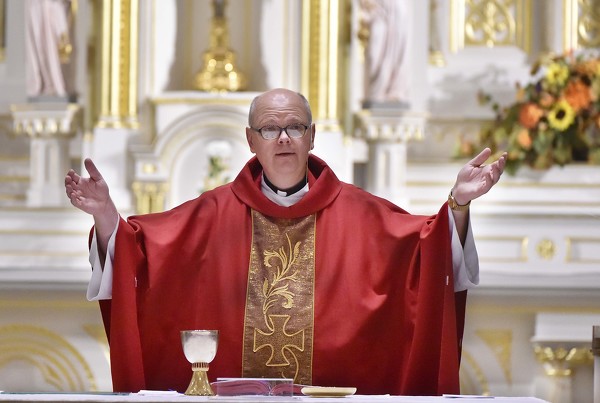Saturday, November 6th, 2021
Changes coming
Priests will serve more local parishes
By William Kincaid

Photo by Dan Melograna/The Daily Standard
Father Ken Schnipke celebrates Mass recently at Immaculate Conception Catholic Church in Celina.
All 25 Catholic parishes in Mercer and Auglaize counties will be affected by upcoming pastoral planning changes aimed at addressing a shortage of priests and other shortfalls.
The changes likely will result in priests serving more parishes.
"This process is intended to restructure how the 208 churches in the Archdiocese of Cincinnati (19 counties) are organized so we can more effectively use the priests available, as well as evangelize to Catholics and everyone in our region," said Tom Kueterman, director of St. Marys Deanery, in an email.
The Archdiocese of Cincinnati is in the midst of an unprecedented regrouping of resources to reset for future growth, said Catholic officials. The multi-year process of pastoral planning has been dubbed Beacons of Light.
Parishes will be grouped into Families of Parishes, according to the Beacons of Light website.
It involves a study of every aspect of the archdiocese and parishes to determine how to best organize resources - human, physical and financial - to spread the Gospel, the website states.
Draft models of Families of Parishes were published for comment this fall. The models were created based on analyzing data that was reviewed by teams of priests, Pastoral Center and Catholic Schools Office staff and Archbishop Dennis Schnurr, according to Beacons of Light. Data was collected from parishes and schools during the past 5 to 10 years on average but excluded the COVID-19 year of 2020, the information states.
Data analyzed include the number of weekend Masses; church seating capacity; Mass attendance; Catholic households; parish sacramental, faith formation and funeral records; parish and school finances; and projected number of priests available for assignment over the next 10 years.
Under the draft model, for example, new Families of Parishes would include NW-2, consisting of St. Teresa of Rockford, Immaculate Conception of Celina, Holy Rosary of St. Marys and St. Patrick of Glynwood, overseen by two priests; and NW-1, consisting of St. Anthony of St. Anthony, Holy Trinity of Coldwater, St. Peter of St. Peter, St. Marys of Philothea, St. Joseph of St. Jospeh, Mary Help of Christians of Fort Recovery and St. Paul of Sharpsburg, all would be overseen by three priests.
Comments on the draft models were accepted through Oct. 20. A total of 7,822 comments were received by the archdiocese, said Jennifer Shack, archdiocese spokeswoman.
"We are actively having meetings to go through those comments and to find the areas that there's a common theme between pastors, principals, priests and the faithful of areas of concern," she said.
Archdiocese leaders aim to announce the finalized Families of Parishes in December, Schack said. Then, the archdiocese will help pastors and parish leaders prepare for the transition to the new parish structures, which will be implemented this summer, she said.
The strategic planning of Beacons of Light realizes it may take time for a priest to get acquainted to the parishes and a larger population, she continued.
"But the reality of realigning resources, asking for lay involvement to be more active in the parishes, allowing for Father to more focus on spiritual leadership, is part of the hope for where we go for Beacons of Light," she said.
Additionally, some parishes may excel at certain aspects of evangelization, such as youth ministry, that all parishioners in a new parish family could access, Schack said.
Father Alexander Witt, pastor of Holy Rosary and St. Patrick parishes in St. Marys, said priests are stretched to the limit and many parishes are limping along. Beacons of Light has the potential to reinvigorate Catholic life in a number of ways, he said.
"By better resource management, the priest won't be tied down by so many meetings and a burdensome Mass schedule," Witt wrote. "This leaves him with time and energy to be spent elsewhere and this is where the people are going to benefit.
"Growing up, the only thing we expected from our priests is that they said Mass because that was all he had time for. With the Beacons, I hope that parishioners will begin to see that their priest has more time to be a father to them. I'm already looking forward to the potential of being able to spend more time getting to know parishioners as well as working toward faith formation and mobilization of the laity to help them grow in faith and holiness," Witt said.
The average Sunday Mass in the archdiocese is only one-third full, the Beacon of Light website states, and the number of registered Catholic households in the Archdiocese has declined at a rate of 2.72 households per day for the past decade.
Meanwhile, the number of available priests is expected to drop by about 20% by 2026, the website states.
As a result, most church buildings are grossly underutilized, resources are spread too thin and many parishes are not the vibrant communities of faith Catholics need them to be, according to the website.
Without the restructuring, the situation would only deteriorate, Witt said, calling the process necessary. He views it as an attempt to work toward a solution to the problems facing parishes before they reach a critical melting point.
The restructuring should set up the Archdiocese for success in the long run, even if short term sacrifices must be made, he said.
